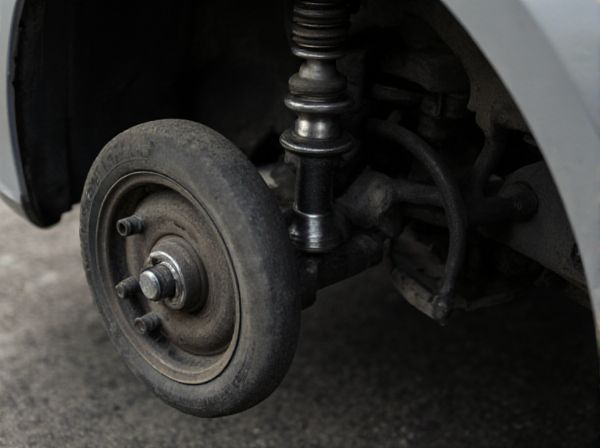
Photo illustration: Rear Axle vs Front Axle
The rear axle supports the weight of the vehicle and provides power to the wheels in rear-wheel or all-wheel-drive systems, enhancing traction and load capacity. The front axle primarily handles steering and supports front-wheel-drive mechanics, influencing vehicle maneuverability and handling. Understanding the differences helps you maintain your vehicle's performance and safety by addressing specific axle-related issues efficiently.
Table of Comparison
| Feature | Rear Axle | Front Axle |
|---|---|---|
| Position | Located at the back of the vehicle | Located at the front of the vehicle |
| Function | Transmits power from the engine to the rear wheels | Supports steering and handles front wheel drive power |
| Steering | Generally non-steering | Primary steering axle |
| Load Capacity | Supports a significant portion of the vehicle's weight | Supports weight and assists in maneuverability |
| Types | Semi-floating, full-floating, or dead axles | Often includes steering knuckles and suspension components |
| Role in Drivetrain | Common in rear-wheel and four-wheel drive vehicles | Common in front-wheel and four-wheel drive vehicles |
| Maintenance | Requires lubrication and inspection of differential and bearings | Requires alignment checks and steering component maintenance |
Introduction to Vehicle Axles
Vehicle axles serve as crucial components in supporting the weight of a vehicle and facilitating wheel rotation. Rear axles typically handle heavier loads and transmit engine power to the drive wheels, especially in rear-wheel-drive vehicles. Front axles, often involved in steering, absorb impact from road irregularities while maintaining directional control.
What is a Front Axle?
A front axle is a critical component of a vehicle's suspension system that connects the front wheels and supports the vehicle's weight while enabling steering and handling. It typically incorporates the steering knuckles, wheel hubs, and sometimes drive components in front-wheel-drive vehicles. The front axle plays a vital role in maintaining stability, absorbing road shocks, and ensuring precise directional control.
What is a Rear Axle?
A rear axle is a critical component in vehicles, responsible for transmitting power from the engine to the rear wheels, enabling movement and load-bearing. Unlike the front axle, which primarily handles steering, the rear axle supports the vehicle's weight and manages torque for propulsion. Rear axles are commonly found in rear-wheel-drive and four-wheel-drive vehicles, optimizing traction and stability during acceleration.
Key Differences Between Front and Rear Axles
The primary differences between front and rear axles lie in their functions and design: front axles typically handle steering and often support drive components in front-wheel drive vehicles, while rear axles mainly provide power transmission to the wheels and bear the vehicle's load. Front axles generally incorporate more complex suspension and steering elements, whereas rear axles are designed to handle heavier torque loads and facilitate differential housing. Weight distribution, drive configuration, and vehicle suspension design critically influence the structural and operational distinctions between front and rear axles.
Functional Roles of Front and Rear Axles
The front axle primarily facilitates steering by allowing the wheels to pivot and control the vehicle's direction, while also supporting the engine and front suspension. The rear axle mainly transmits power from the engine to the wheels, bearing the vehicle's load and contributing to traction and stability. Both axles work together to ensure balanced weight distribution and optimal vehicle dynamics during acceleration, braking, and cornering.
Performance Impact: Front vs Rear Axle
Rear axles typically enhance vehicle stability and traction, especially during acceleration and towing, by effectively transferring power to the road. Front axles improve steering response and handling, offering better control in tight corners and during precise maneuvers. The performance impact of front versus rear axles significantly depends on drivetrain configuration, weight distribution, and driving conditions, with rear axles favoring power delivery and front axles emphasizing steering dynamics.
Durability and Maintenance Considerations
Rear axles generally offer superior durability due to their robust construction and ability to handle higher torque loads, making them ideal for heavy-duty applications. Maintenance of rear axles often involves less frequent service intervals compared to front axles, as they experience less steering-related stress and wear. Front axles require more regular inspection and lubrication due to steering components and constant load shifts, which can accelerate wear and impact long-term reliability.
Applications in Different Vehicle Types
Rear axles are predominantly utilized in trucks, SUVs, and performance cars for improved traction and load-bearing capabilities on heavy or uneven terrains. Front axles are common in front-wheel-drive vehicles and lighter passenger cars, offering better fuel efficiency and easier steering control. Vehicles like all-wheel-drive models integrate both axles to balance power distribution and enhance overall stability across diverse driving conditions.
Pros and Cons of Front and Rear Axles
Front axles provide improved steering control and better traction in front-wheel-drive vehicles, enhancing maneuverability in tight spaces and slippery conditions. Rear axles offer superior load-bearing capacity and durability, making them ideal for heavy-duty applications and rear-wheel-drive setups. However, front axles can experience higher wear due to steering dynamics, while rear axles may compromise fuel efficiency and handling in sharp turns.
Which Axle is Best for Your Needs?
Choosing between a rear axle and a front axle depends on your vehicle's purpose and driving conditions. Rear axles provide better traction and load-bearing capacity, ideal for towing and heavy-duty tasks, while front axles offer improved steering control and handling, especially in front-wheel-drive vehicles. Evaluate factors like terrain, load requirements, and vehicle type to determine the best axle for your specific needs.
 caratoz.com
caratoz.com